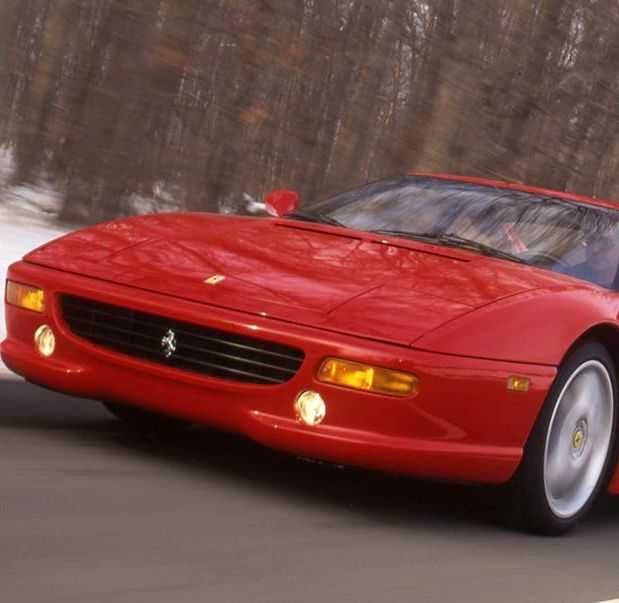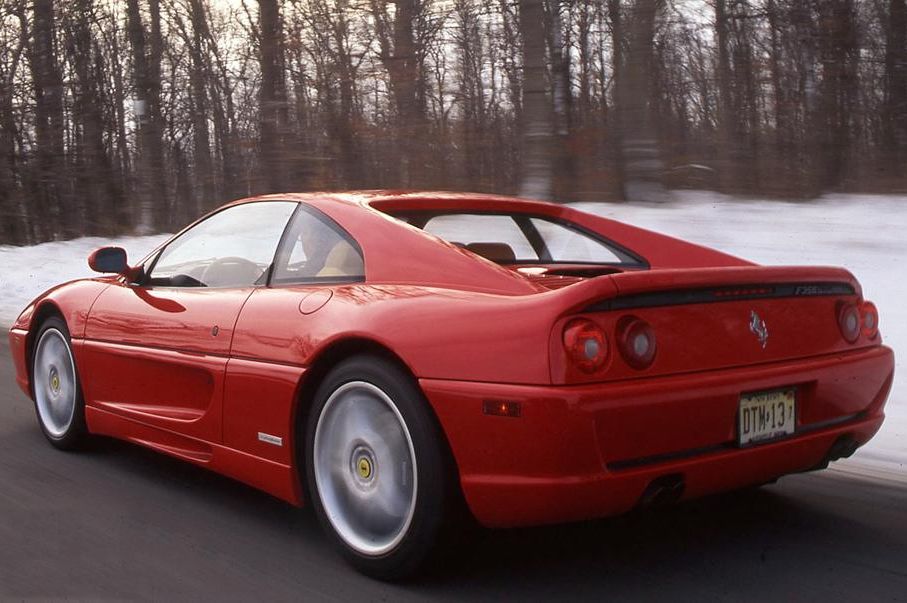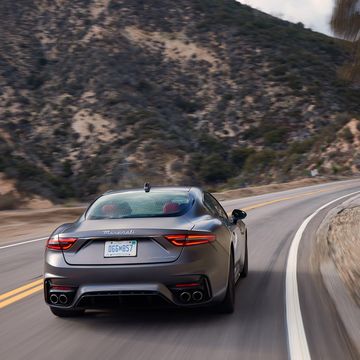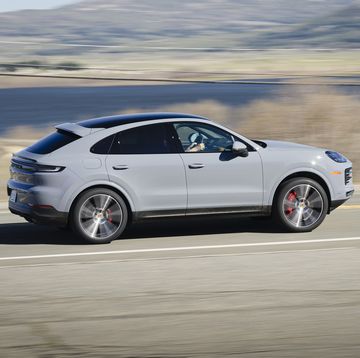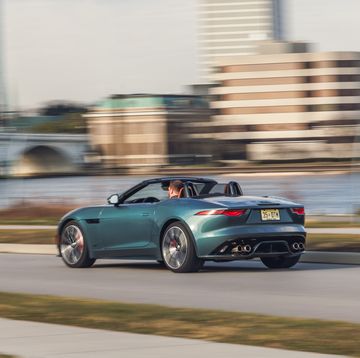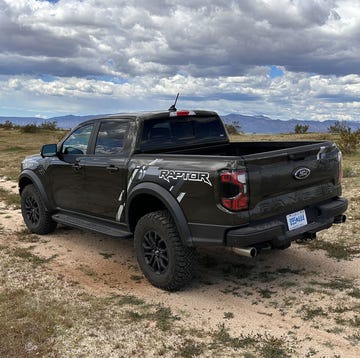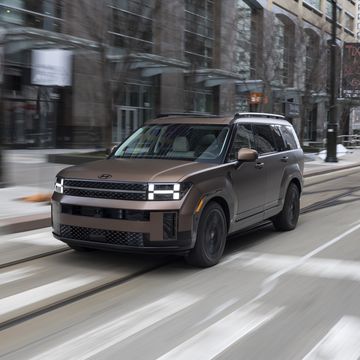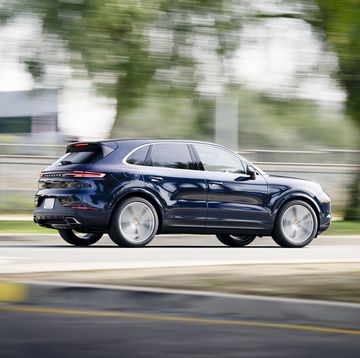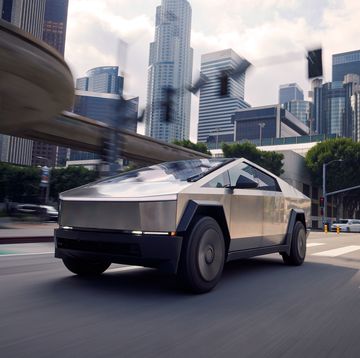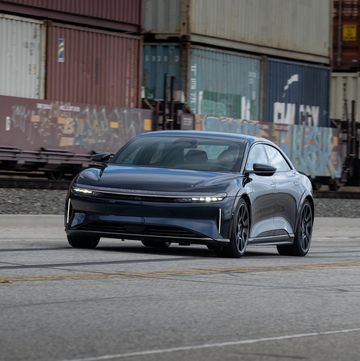From the March 1995 issue of Car and Driver.
No Ferrari F355 owner in their right mind would drive one of these art treasures in the wintry conditions we experienced while the car was in Ann Arbor, but what could we do? New Ferraris do not come our way often, and we don't pick the dates. So we ended up stabbing a flaming-red F355 through snow flurries and road-salt spray, cringing at these abuses as our admiration for the car's capabilities grew.
The F355 is Ferrari's replacement for the 348, and although it's based on that car's layout, it is a generation ahead of the 348 in every way. Still, there's no mistaking it for anything other than a red car from Maranello when you first approach it. After hunting for the door handle (it's hidden under the intake duct) and opening the door, the impression is heightened. On the other side of a wide, flat doorsill is a low, leather-wrapped seat and, in front of it, a handsome three-spoked wheel with a big yellow prancing-horse badge sitting atop an airbag. Alongside the seat is the traditional metal gearshift maze—now with seven slots—sprouting a polished steel shaft with an alloy ball at its peak.
You vault the sill, twist into the seat, and slide your feet down to shiny metal pedals offset slightly to the center of the car. A hoarse bark greets the starter, then the engine settles to a deep, resonant idle. Prods at the pedal send the revs soaring, and you hear the twang of an unconstricted exhaust system and the whiz of a small, responsive V-8. Five valves serve each cylinder, but they're operated by belt-driven cams and hydraulic tappets; as a result, the valvetrain is unexpectedly quiet.
A tachometer redlined at 8500 rpm suggests a peaky engine and a dull, off-song response to the throttle at low revs, but that isn't the case. In fact, the F355 pulls willingly almost from idle, with no snatching or shuffle. It'll run easily with traffic at under 4000 rpm, accelerating steadily and acting as well mannered as a kid's pony. The only impediment to gracious around-town cruising is a throttle pedal with some initial stiction in the movement. This makes smooth shifting more difficult than it need be. A pity, now that the car's transmission oil is warmed by an engine‑coolant heat-exchanger, and the shifter moves easily almost from the start.
With a more predictable throttle action, you would be able to add the precise amount of power needed to produce seamless shifts. If we owned an F355, we'd massage the linkage immediately. Naturally, it's less of a problem on the open road, where sixth gear offers enough response to pass other cars even when using only the first half of the tachometer. Of course, you can also clack the lever down a cog or two and flash by so fast that other drivers will think someone repainted the Starship Enterprise.
Because the Ferrari engine has a 180-degree crankshaft, (which produces equal firing intervals on each cylinder bank for best exhaust timing), its firing order is more like two straight-fours than the four V-twins of the typical arrangement. So it sounds more like a demented four-cylinder motorcycle than a NASCAR stocker at high speed. It also puts 375 horsepower to the ground in a convincing display of power. From a standing start, if you can balance the powertrain on the knife-edge between tire smoke and clutch smoke, 60 mph can be reached in 4.5 seconds. That makes it faster than a 405-horsepower 5.7-liter ZR-1 Corvette (4.7 seconds).
It's also faster than all the new Porsche 911s except the blindingly quick 3.6 Turbo (which hasn't come to the U.S. yet). Once you've discovered how readily the 3.5-liter V-8 spins to its 8500-rpm redline, you begin to exploit the car's long, delicious blasts of power in each gear. The experience is intense, accompanied by the frenzy of a 40-valve engine with a full repertoire of scalp-prickling harmonics. The car's top end is equally impressive. We managed a maximum speed of 179 mph at the redline in sixth gear. But we have every confidence in the factory's claim of 183 mph because of the car's eagerness to pull beyond the redline—assuming we were willing to risk the engine. On the public road, as you can imagine, the F355 is a license looking for suspension. Despite comparatively low gearing, the car treats three-digit speeds as just something else to pass.
Thanks to extensive chassis tuning work, the F355's suspension takes the enormous thrust of its engine in stride. An electronically managed variable shock-absorber system reads data from various sensors and adjusts damping forces through a wide range of values to control wheel movement. There's an override button that allows the driver to select the comfort level, but the chassis now has a degree of initial compliance that makes the car feel supple and slightly cushioned anyway, even on Michigan's washboard byways. Of course, if you dial the speed way up, the system goes into the fully firm mode, and then you hear some rumbling from the undercarriage, as well as messages through the structure that suggest that Ferrari's central steel cell with tube subframes may still be a tad less substantial than the all-alloy monocoque of an Acura NSX.
Anyone familiar with the stiff, high-geared manual steering of earlier Ferraris will welcome the new TRW power-steering system. This mechanism takes over the iron-pumping job from your arms during low-speed maneuvering, and enables the driver to make quick steering corrections without the exertion these cars used to require.
Perhaps more important than the ease with which the car changes direction is its high-speed stability. The wheel still pulses information into your palms as the front wheels read the road surface, yet it refrains from arm-wrestling the driver, and kickback shock has been virtually eliminated. This is real progress—but for the diehards who believe Ferraris have to be difficult to drive, there is an unassisted steering option available.
TRW's steering helps this new Ferrari turn in with surgical precision, its Pirelli P-Zero system rubber clinging with an impressive 0.98 g of grip. We expected the Z-rated rubber to be a problem in the winter, and although we were once immobilized after overnight temperatures had hardened a snowy driveway as well as the tires' compound, the P-Zeros proved surprisingly good in cold, wet conditions.
Equally welcome in the prevailing conditions was an anti-lock braking system monitoring the activities of four very capable rotor and caliper teams. In concert with a clear and progressive pedal, these components produced excellent stopping distances at the test track, with no sign of fade. During normal driving, the temperature wasn't high enough to silence the squeals of protest from chilly pads until the brakes were worked hard. In hotter climates, the front brakes will benefit from cooling ducts built into the new grille.
Driven in good weather, this F355 will undoubtedly bring great pleasure to its well-heeled owners. The climate-control system worked well in winter; no doubt the CFC-free air conditioning will perform as well in summer. After all, there are new arbiters of these matters at Ferrari now. As we said earlier, no Ferrari owner in his (or her) right mind would drive in the conditions we endured during this test. But if the car was this good in the freezing, slushy December weather, imagine how wonderful it will be in the warm and dry good times of summer. Please, Ferrari, can we have one then?
Counterpoints
This 355 is easily the best eight-cylinder Ferrari I've ever driven. Previous 308-348 models have delivered full measures of the Ferrari image and excitement, but they have been wanting in the behind-the-wheel qualities on which the marque's sterling sporty image was built. Handling in those cars ranged from twitchy to evil, and ergonomic and shift quality were sources of irritation rather than satisfaction. Worst of all, those Ferraris were short on speed, typically unable to keep up with contemporary Corvettes. These blemishes have been comprehensively rectified in the 355. Finally, we have a V-8 Ferrari worthy of the prancing horse. —Csaba Csere
James Thurber once wrote of a European car, "The gadgets on the dash and on the floorboard, which he pulled and pushed to make the thing go, seemed to include fire tongs, spoons, and doorknobs.'' Actually, the F355 could use a doorknob, because its door handles are otherwise difficult to locate. And the fire-tong shift lever, clacking its way slowly between metallic gates, makes the noises of dropped kitchenware. Of course, if you want to mask the sounds of the shifter, just zing this little V-8 to eight grand or so and listen to the music. —John Phillips
Maybe a sushi bar opened in Maranello, maybe Shinto missionaries have been working northern Italy, or just maybe someone at Ferrari drove an NSX and took notes. What else could account for the F355's ergonomic cockpit, its improved visibility, and its superb new climate-control system? Power steering even makes it easy to park. Well, praise Buddha, or Hail Mary—whatever diety expunged the bad Ferrari genes also enhanced the good ones. The new V-8 and the improved chassis deliver the blistering performance, confident handling, and high-speed stability that the 348 lacked. I want one. —Frank Markus
